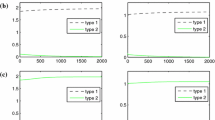Abstract
It is widely believed that the slowest dispersal strategy is selected in the evolutional if the environment is temporally invariant but spatially heterogeneous. Authors claim in this paper that this belief is true only if random dispersals with constant motility are considered. However, if a dispersal strategy with fitness property is included, the size of the dispersal is not such a crucial factor anymore. Recently, a starvation driven diffusion has been introduced by Cho and Kim (Bull. Math. Biol., 2013), which is a random dispersal strategy with a motility increase on starvation. The authors show that such a dispersal strategy has fitness property and that the evolutional selection favors fitness but not simply slowness. Such a conclusion is obtained from a stability analysis of a competition system between two phenotypes with different dispersal strategies of linear and starvation driven diffusions.


Similar content being viewed by others
References
Averill, I., Lou, Y., & Munther, D. (2012). On several conjectures from evolution of dispersal. Journal of Biological Dynamics, 6, 117–130.
Belgacem, F., & Cosner, C. (1995). The effects of dispersal along environmental gradients on the dynamics of populations in heterogeneous environments. Can. Appl. Math. Q., 3(4), 379–397.
Bezuglyy, A., & Lou, Y. (2010). Reaction–diffusion models with large advection coefficients. Appl. Anal., 89(7), 983–1004.
Cantrell, R. S., & Cosner, C. (2003). Wiley series in mathematical and computational biology. Spatial ecology via reaction–diffusion equations. Chichester: Wiley
Cantrell, R. S., Cosner, C., & Lou, Y. (2008). Approximating the ideal free distribution via reaction–diffusion–advection equations. J. Differ. Equ., 245, 3687–3703.
Cantrell, R. S., Cosner, C., & Lou, Y. (2010). Evolution of dispersal and ideal free distribution. Math. Biosci. Eng., 7, 17–36.
Cho, E., & Kim, Y.-J. (2013). Starvation driven diffusion as a survival strategy of biological organisms. Bull. Math. Biol.
Cohen, D., & Levin, S. A. (1991). Dispersal in patchy environments: the effects of temporal and spatial structure. Theor. Popul. Biol., 39(1), 63–99.
Cosner, C. (2005). A dynamic model for the ideal-free distribution as a partial differential equation. Theor. Popul. Biol., 67, 101–108.
Cosner, C., & Lou, Y. (2003). Does movement toward better environments always benefit a population? J. Math. Anal. Appl., 277(2), 489–503.
Cosner, C., Dávila, J., & Martínez, S. (2012). Evolutionary stability of ideal free nonlocal dispersal. J. Biol. Dyn., 6, 395–405.
Dieckman, U., O’Hara, B., & Weisser, W. (1999). The evolutionary ecology of dispersal. Trends Ecol. Evol., 14(3), 88–90.
Dockery, J., Hutson, V., Mischaikow, K., & Pernarowski, M. (1998). The evolution of slow dispersal rates: a reaction diffusion model. J. Math. Biol., 37(1), 61–83.
Fretwell, S. D. (1972). Populations in a seasonal environment. Princeton: Princeton University Press.
Fretwell, S. D., & Lucas, H. L. Jr. (1970). On territorial behavior and other factors influencing habitat distribution in birds, I: theoretical development. Acta Biotheor., 19, 16–36.
Hambrock, R., & Lou, Y. (2009). The evolution of conditional dispersal strategies in spatially heterogeneous habitats. Bull. Math. Biol., 71(8), 1793–1817.
Holt, R., & McPeek, M. (1996). Chaotic population dynamics favors the evolution of dispersal. Am. Nat., 148, 709–718.
Hsu, S. B., Smith, H. L., & Waltman, P. (1996). Competitive exclusion and coexistence for competitive systems on ordered Banach spaces. Trans. Am. Math. Soc., 348(10), 4083–4094.
Hutson, V., Mischaikow, K., & Poláčik, P. (2001). The evolution of dispersal rates in a heterogeneous time-periodic environment. J. Math. Biol., 43(6), 501–533.
Johnson, M., & Gaines, M. (1990). Evolution of dispersal: theoretical models and empirical tests using birds and mammels. Annu. Rev. Ecol. Syst., 21, 449–480.
Keeling, M. (1999). In J. McGlade (Ed.), Spatial models of interacting populations, advanced ecological theory: principles and applications, Oxford: Blackwell Science.
Kim, Y.-J., Kwon, O., & Li, F. (2013). Global asymptotic stability and the ideal free distribution in a starvation driven diffusion. J. Math. Biol. doi:10.1007/s00285-013-0674-6.
Lam, K.-Y., & Ni, W.-M. (2010). Limiting profiles of semilinear elliptic equations with large advection in population dynamics. Discrete Contin. Dyn. Syst., 28(3), 1051–1067.
McPeek, M., & Holt, R. (1992). The evolution of dispersal in spatially and temporally varying environments. Am. Nat., 140, 1010–1027.
Nagylaki, T. (1992). Biomathematics: Vol. 21. Introduction to theoretical population genetics. Berlin: Springer.
Ni, W.-M. (2011). CBMS-NSF regional conference series in applied mathematics: Vol. 82. The mathematics of diffusion. Philadelphia: SIAM.
Okubo, A., & Levin, S. A. (2001). Interdisciplinary applied mathematics: Vol. 14. Diffusion and ecological problems: modern perspectives (2nd ed.). New York: Springer.
Tindall, M. J., Porter, S. L., Maini, P. K., Gaglia, G., & Armitage, J. P. (2008). Overview of mathematical approaches used to model bacterial chemotaxis, I: the single cell. Bull. Math. Biol., 70(6), 1525–1569.
Travis, J. M. J., & Dytham, C. (1999). Habitat persistence, habitat availability and the evolution of dispersal. Proc. R. Soc. Lond. B, 266, 723–728.
Yoon, C., & Kim, Y.-J. (2013). Bacterial chemotaxis without gradient-sensing. arXiv:1307.6071.
Acknowledgements
Y.J. Kim was supported by NRF of Korea (No. 2009-0077987) and F. Li was supported by Chinese NSF (No. 11201148), Shanghai Pujiang Program (No. 13PJ1402400), China Postdoctoral Science Foundation (No. 2012M510108) and ECNU Foundation (No. 78210164).
Author information
Authors and Affiliations
Corresponding author
Rights and permissions
About this article
Cite this article
Kim, YJ., Kwon, O. & Li, F. Evolution of Dispersal Toward Fitness. Bull Math Biol 75, 2474–2498 (2013). https://doi.org/10.1007/s11538-013-9904-8
Received:
Accepted:
Published:
Issue Date:
DOI: https://doi.org/10.1007/s11538-013-9904-8




